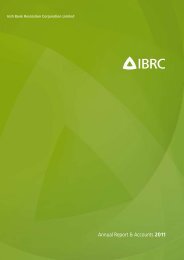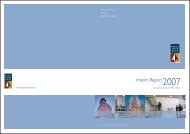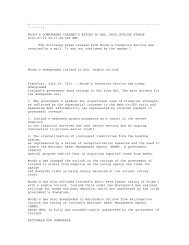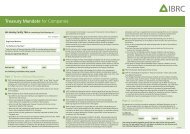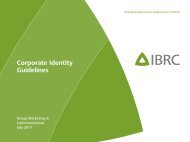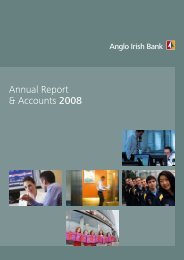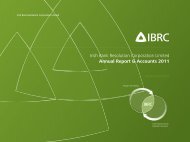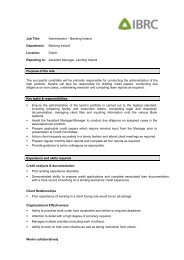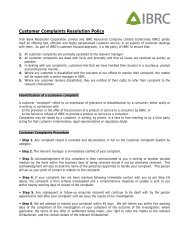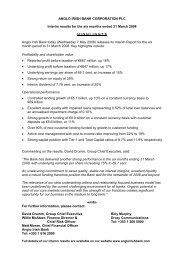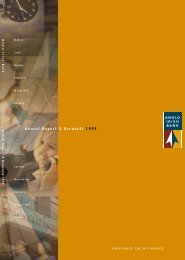Annual Report & Accounts 2009 - Anglo Irish Bank
Annual Report & Accounts 2009 - Anglo Irish Bank
Annual Report & Accounts 2009 - Anglo Irish Bank
Create successful ePaper yourself
Turn your PDF publications into a flip-book with our unique Google optimized e-Paper software.
Notes to the financial statements continued<br />
1. General information and accounting policies continued<br />
1.33 Significant accounting estimates and judgements continued<br />
Taxation<br />
The taxation charge accounts for amounts due to fiscal authorities in the various jurisdictions in which the Group operates and includes<br />
estimates based on a judgement of future profits and the application of law and practice in certain cases in order to determine the<br />
quantification of any liabilities arising. In arriving at such estimates, management assesses the relative merits and risks of tax treatments<br />
assumed, taking into account statutory, judicial and regulatory guidance and, where appropriate, external advice. Where the final tax<br />
outcome is different from the amounts that are currently recorded, such differences will impact upon the current and deferred tax<br />
amounts in the period in which such determination is made.<br />
Retirement benefits<br />
The Group operates defined benefit pension schemes. The Group’s two schemes have been closed to new members since January 1994.<br />
In determining the actual pension cost, the values of the assets and liabilities of the schemes are calculated. The assets of the schemes<br />
are valued at fair value. The liabilities of the schemes are measured on an actuarial basis, using the projected unit method and<br />
discounted at the current rate of return on a high quality corporate bond of equivalent term and currency to the liabilities. This involves<br />
modelling the future growth of scheme liabilities and requires management to make assumptions as to price inflation, dividend growth,<br />
salary and pensions increases, return on investments and employee mortality. There are acceptable ranges in which these estimates can<br />
reasonably fall. The impact on the Consolidated income statement and the Consolidated statement of financial position could be<br />
materially different if an alternative set of assumptions was used.<br />
1.34 Prospective accounting changes<br />
Details of amendments to standards and interpretations adopted during the period are set out in note 1.3. The Group has not applied<br />
the following new standards, amendments to standards and interpretations that have been approved by the International Accounting<br />
Standards Board and which would be applicable to the Group with an effective date after the date of these financial statements.<br />
The following will be applied in 2010:<br />
� Amendments to IFRS 2 - Share-based Payment;<br />
� IFRS 3 Revised - Business Combinations;<br />
� Amendments to IFRS 5 - Non-Current Assets Held for Sale and Discontinued Operations;<br />
� Amendment to IFRS 7 - Financial Instruments: Disclosures;<br />
� IFRS 8 - Operating Segments;<br />
� Further amendments to IAS 1 - Presentation of Financial Statements;<br />
� Amendment to IAS 7 - Statement of Cash Flows;<br />
� Amendment to IAS 16 - Property, Plant and Equipment;<br />
� Amendment to IAS 17 - Leases;<br />
� Amendment to IAS 19 - Employee Benefits;<br />
� Amendment to IAS 20 - Government Grants and Disclosure of Government Assistance;<br />
� Amendments to IAS 23 - Borrowing Costs;<br />
� Amendments to IAS 27 - Consolidated and Separate Financial Statements;<br />
� Amendments to IAS 28 - Investments in Associates;<br />
� Amendments to IAS 31 - Interest in Joint Ventures;<br />
� Amendments to IAS 36 - Impairment of Assets;<br />
� Amendments to IAS 38 - Intangible Assets;<br />
� Amendments to IAS 39 - Financial Instruments: Recognition and Measurement – Eligible Hedged Items;<br />
� Amendment to IAS 40 - Investment Property; and<br />
� IFRIC Interpretation 17 - Distributions of Non-cash Assets to Owners.<br />
The following will be applied in 2011:<br />
� Amendment to IAS 24 - Related Party Disclosures;<br />
� Amendments to IAS 32 - Financial Instruments: Presentation;<br />
� Amendment to IFRIC Interpretation 14 - IAS 19 - The Limit on a Defined Benefit Asset, Minimum Funding Requirements and their<br />
Interaction; and<br />
� IFRIC Interpretation 19 - Extinguishing Financial Liabilities with Equity Instruments.<br />
The following will be applied in 2013:<br />
� IFRS 9 - Financial Instruments: Classification and Measurement.<br />
These will be adopted in future years and, with the exception of IFRS 9 and the amendments to IFRS 7 and IAS 24, are not expected to<br />
have a material impact on the <strong>Bank</strong>'s results or financial statements.<br />
IFRS 9 will ultimately replace IAS 39 - Financial Instruments: Recognition and Measurement. Its aim is to reduce the complexity of<br />
accounting for financial assets and in so doing to aid investors’ and other users’ understanding of financial information. IFRS 9 uses a<br />
single approach to determine whether a financial asset is measured at amortised cost or fair value, replacing the many different rules in<br />
IAS 39. It also requires a single impairment method to be used which replaces the various methods currently prescribed in IAS 39.<br />
The amendment to IFRS 7 requires the use of a three-level fair value hierarchy to provide additional disclosures about the relative<br />
reliability of measurement bases used to calculate financial instrument fair values. In addition, the amendment requires enhanced<br />
disclosures in respect of liquidity risk.<br />
The amendment to IAS 24 simplifies the disclosure requirements for Government-related entities and clarifies the definition of a related<br />
party.<br />
58



